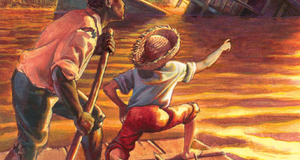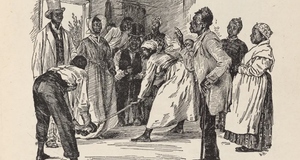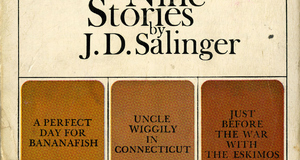Mark Twain's Portrayal of Family and Relationships in Adventures of Huckleberry Finn
By
2014, Vol. 6 No. 03 | pg. 2/2 | « Family Values of the Time PeriodExamining the typical family structures of the Gilded Age, along with the gradual shifts in family values during that period, allow for a more in depth understanding of Mark Twain’s view of the family. Rodney Carlisle points out that “by this time in history the family had lost … its role as an economically productive unit or a means of maintaining order and control in society” (19) and, consequently, public and private institutions assumed these tasks. William Bridges attests that the “stereotype[d]” nineteenth-century American family with “the image of a closely-knit, stable, patriarchal, self-sustaining, well-disciplined family group” (4) is a great misconception and that in fact, many writers of that era were characterizing children as “hav[ing] their own way,” with “self-assertion, and conceit … insubordination … and a general want of respect for age” (5). Even as early as 1817 it was written that children “are absolute masters of their fates. The authority of the parents is no restraint at all” (Bridges 5). Although, according to Steven Mintz, “the family was expected to serve the political order by diffusing self-serving needs and by instilling the values of willing obedience, service, and rational impartiality” (394), there had been a major failure in this area, which “seemed to explain an alarming increase in violence, robbery, prostitution, and drunkenness” (395). Sherri Maxine Broder highlights the gradual disintegration of the relationships of family members as their traditional or expected roles and responsibilities became blurred. When the men of working-class families discovered that it was often easier and more lucrative to desert their families and wander as a tramp or beggar, they contributed to a growing number of fatherless families in which the “women and children [were forced] either to assume the man’s role of breadwinning, or to turn to the charities for the economic support they should have found at home” (Broder 17). Mark Twain was greatly influenced by the culture around him, and these aforementioned aspects of Gilded Age society and family structure are perceptible in the various families depicted in Huck Finn. The mounting unruliness and independence of children in that era are clearly replicated in Huck as he narrates his adventures, and from the very beginning his strong-willed, self-reliant nature emerges vividly. While living with the Widow Douglas, a punctilious elderly woman, and her sister Miss Watson, a pious, finicky, “tolerable slim old maid” (Twain 4), Huck displays his determination and independence in striking contrast to the regulated, proper ways of the women. They are constantly in conflict with Huck’s vulgar habits and uncivilized mannerisms, and their chief goal as far as Huck is concerned is to “sivilize” (Twain 3) his wild ways, convert his soul, and educate his unlearned mind. Huck, vehemently opposed to his guardians’ brand of civilization, views that life as “rough living” and the women as “dismal regular and decent” (Twain 3), and longs to be free of restraint and regulation. A major contributor to Huck’s manner of living is his father, to whom Huck refers as Pap. Pap’s vagrant, drunken lifestyle is an illustration of the common situation in the Gilded Age—a tramp-like father and a destitute family. Because of Pap’s abusive treatment, Huck dreads Pap’s returns from his wanderings, which always signal a renewal of abuse toward Huck. Although Huck encounters many family groups throughout his adventures, he constantly yearns for freedom and ultimately follows in the footsteps of his father, assuming a tramp’s life detached from the obligations and responsibilities of a family. Mark Twain’s ‘Ideal’ FamilyBy exploring the state of the family in that era and Twain’s own family experiences, we can form certain suppositions about Twain’s ideal family structure and further identify the manner in which he portrays that ideal in The Adventures of Huckleberry Finn. His beliefs and ideals regarding the family were heavily swayed by his personal family life and the contrasting family structures in the society around him. Due to the stable, positive family relationships in his own life, Twain appears to have acquired high standards and principles for what a model family would look like and subtly promotes these standards in Huck Finn. His model family would manifest a strong, stable structure with responsible, caring parents and affectionate relationships, and would uphold such values as loyalty, responsibility, honesty, courage, and sacrifice. Throughout the narrative, Twain introduces readers to numerous family conditions that indicate not only the necessary features of an ideal family but also his disapproval of the mainstream family of his day. Robert Shulman suggests, “Ideally, families provide a sense of belonging, of cohesiveness, and they encourage the individual to develop his unique potentialities as part of the family and society” (35), but, as James Grove indicates, Twain’s books are “filled with people trying to cope with disrupted familial relations,” which “[help] define [Twain’s] abiding ambivalence toward the family” (377).Indeed, at almost every location at which Huck encounters a family group, he discovers an abundance of broken or strained relationships and loves his own independent, carefree life too much to remain within the rigid domestic structure. The first situation in which we find Huck is “a fragmented family” (Shulman 34) consisting of Huck, the Widow Douglas, and her sister Miss Watson, a situation in which the widow and her sister attempt to bring Huck under their authority and “fit him into the mold of respectability,” but “without taking his needs, feelings, or nature into account” (Shulman 35). Huck’s longing for freedom and the women’s intolerance for unruly behavior create an incompatibility between them and their foster child, causing deteriorating relationships and conflicting values. Another major family unit Huck is involved in is his only remaining family member, Pap. Although this family link is one of flesh and blood, it is glaringly opposed to Twain’s ideal family situation. Pap’s abusive, drunken behavior toward Huck illustrates the failure of many fathers of that era to lead the family with kindness and selflessness, and eventually causes Huck to make his desperate escape from all family restrictions. After journeying down the Mississippi River for quite some distance, Huck encounters the feuding families, the Grangerfords and the Shepherdsons, and experiences a few days in the Grangerford’s household. That family, though intact as far as relationships, is strikingly dysfunctional and its members are controlled by violence and the fear of imminent ambush and annihilation by the opposing family. Shulman puts it aptly: “Despite the Sunday values they pay lip service to, the Grangerfords separate brotherly love and positive family feeling from what they are really committed to: killing in the name of conventional honor” (44). Following Huck’s traumatic interaction with the Grangerfords, he and Jim meet the King and the Duke, two rogues or, in Jim’s vernacular, “reglar rapscallions” (Twain 148) who join Huck and Jim for a good third of the book; together, the unlikely foursome function as a family unit, the King and Duke acting as authority figures for the family. However, their relationships are far from ideal. Instead of displaying compassion, honesty, and love toward Huck and Jim, as Twain’s ideal parent/child structure would, the Duke and the King lack any scruples and manipulate the two younger family members to attain their goals. Their “restless pursuit of money and property,” Shulman points out, “[contrasts] with Jim and Huck’s nonacquisitive relation to each other and to the world around them” (37). In contrast to the many fragmented, discordant families in Huck Finn, the only family groups which successfully fulfill the ideal pattern and structure maintained by Twain are that of the Phelps family and Huck and Jim. Shulman suggests that “if the secure good family exists anywhere in the novel, it ought to be at the Phelpses” (43). Of all the family units portrayed in the book, the Phelps family, complete with a responsible and loving father, a conscientious and gentle mother, a brood of young, docile children and a usual “network of family relations” (Shulman 43), appears to be the most parallel to what would be Twain’s model family. The Phelpses possess stability and contentment, leading to a strong foundation and freedom from any major interpersonal disputes. The relationship of Huck and Jim, however, is the ultimate demonstration of Twain’s ideal family relationship. Although their “family” lacks the conventional roles of the father, mother, and children, it nevertheless “embodies an ideal of community that highlights the shortcomings of the actual families and society in the novel” (Shulman 32). Because of Huck’s failed relationship with Pap, Huck is free to “develop in his own way and to develop a genuine relation with Jim” (Shulman 36). However, Andrew Solomon points out that Huck and Jim’s “closeness does not spring fully grown from the head of Twain, but unfolds gradually” (22), and their relationship must undergo a sometimes complicated progression as the two develop in their understanding of one another. Huck struggles several times with his conscience as he chooses between his duty as a Southerner to turn Jim in and his sympathy toward Jim as a fellow human being. It is only when Huck hears of Jim’s capture and remembers all Jim’s kindness toward him that Huck decides to stay by Jim’s side, regardless of the consequences. Long before Huck makes this choice, however, Jim has already demonstrated love and sacrifice toward Huck, even to the point of forfeiting his hard-earned liberty. Jim functions as an antitype to Pap; he is the loving, caring father figure that Huck has never had before. Tom Quirk points out that “Jim’s various protective gestures” give Huck a “sense of belonging” that a home with the widow or the Phelpses could not, but “only by degrees does Huck learn how to respond to Jim’s affection and care” (22). Because of the negatively shifting family structures in the society around him and his desire to express his concerns regarding the necessary traits of an ideal family system, Twain fittingly uses a young boy and his adventures as a vehicle for conveying his deeper implications and admonitions. As Quirk states, “[Twain] must have recognized at some level that he could better ease his own adult worries and youthful longings and speak his own dissatisfactions in the vernacular idiom of a boy who as yet had had no childhood of his own” (20). Much of the time, Twain communicates his message through a startling contrast between faulty families like the Grangerfords or the King and the Duke and ideal families such as the Phelpses and Huck and Jim. This contrast vividly reveals Twain’s admonition toward families of that era to realize their failures and bring moral values back into their relationships. But if Twain’s book had a purposeful message that reached into the hearts of his contemporaneous readers, then surely that message has not changed and presents relevant applications to readers even today. No society or culture has yet existed that did not contain struggling, disunited families with broken and conflicting relationships; therefore, Twain’s overarching message to the modern reader is that although the flawless family will never be found, there are certain timeless principles and values—kindness, selflessness, courage, sacrifice, love, honesty—that, if implemented by each family member, will effectively bring that family to a state of happiness and contentment that cannot be found any other way. ReferencesBlair, Walter. Mark Twain and Huck Finn. Berkeley: U of California P, 1960. Print. Bridges, William E. “Family Patterns and Social Values in America, 1825-1875.” American Quarterly 17.1 (1965): 3-11. JSTOR. Web. 2 Aug. 2013. Broder, Sherri Maxine. Politics of the Family: Political Culture, Moral Reform, and Family Relations in Gilded Age Philadelphia. MA thesis. Brown University, 1988. Ann Arbor: UMI, 1988. AAT 8822630. ProQuest Dissertations and Theses. Web. 10 Sept. 2013. Carlisle, Rodney P. Handbook to Life in America: The Gilded Age: 1870 to 1900. New York: Infobase, 2009. Google Books. Web. 11 Sept. 2013. Fears, David H. “Mark Twain Day By Day: An Annotated Chronology of the Life of Samuel Langhorne Clemens. Volume 1 (1835-1856 and a Sampler of 1880).” Mark Twain Journal 43.1/2 (2005): 1-114. Humanities Source. Web. 6 Aug. 2013. Grove, James. “Mark Twain and the Endangered Family.” American Literature 57.3 (1985): 377-394. Academic Search Premier. Web. 26 July 2013. Mintz, Steven. “Regulating the American Family.” Journal of Family History 14.4 (1989): 387-408. ProQuest. Web. 11 Sept. 2013. Paine, Albert Bigelow. A Short Life of Mark Twain. New York: Harper, 1920. Web. 8 Aug. 2013. Quirk, Tom. Coming to Grips with Huckleberry Finn: Essays on a Book, a Boy, and a Man. Columbia: U of Missouri P, 1993. Print. Shulman, Robert. “Fathers, Brothers, and ‘The Diseased’: The Family and Alienation in Huckleberry Finn.” Social Criticism & Nineteenth-Century American Fictions (1987): 28-49. Essay and General Literature Index (H.W. Wilson). Web. 2 Aug. 2013. Solomon, Andrew. “Jim and Huck: Magnificent Misfits.” Mark Twain Journal 16.3 (1972): 17-24. ProQuest. Web. 25 July 2013. Twain, Mark. The Adventures of Huckleberry Finn. New York: Bantam, 1981. Print. Suggested Reading from Inquiries Journal
Inquiries Journal provides undergraduate and graduate students around the world a platform for the wide dissemination of academic work over a range of core disciplines. Representing the work of students from hundreds of institutions around the globe, Inquiries Journal's large database of academic articles is completely free. Learn more | Blog | Submit Latest in Literature |
















